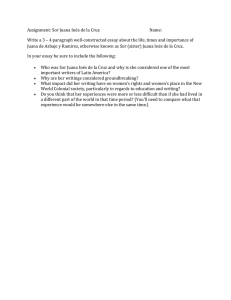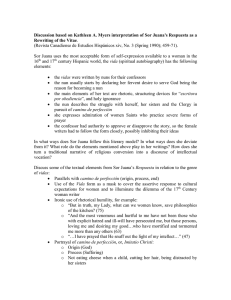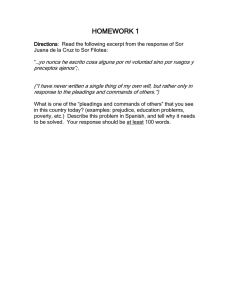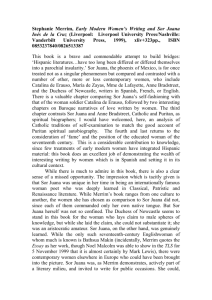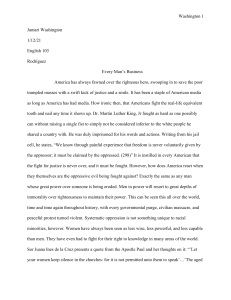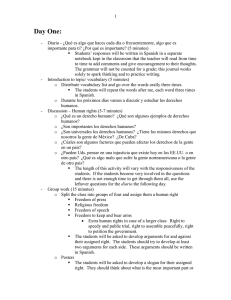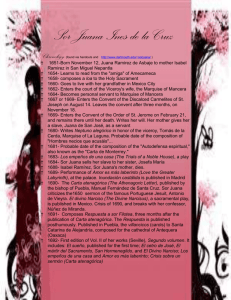The Answer Rhetoric: -- False humility (39, etc.)
advertisement
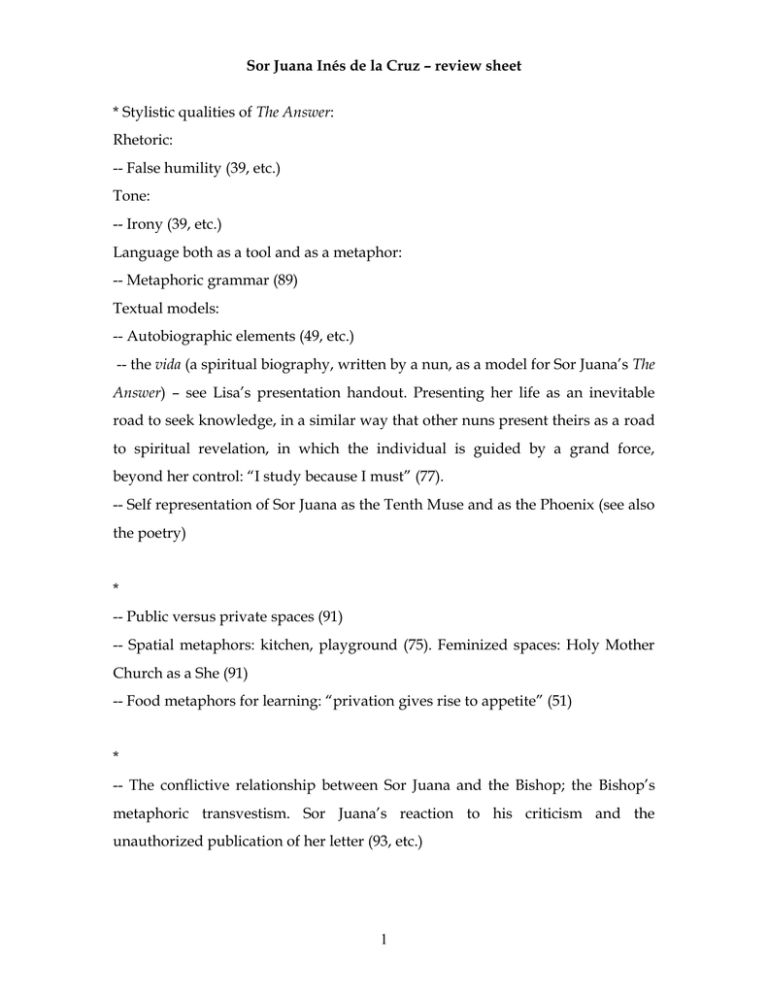
Sor Juana Inés de la Cruz – review sheet * Stylistic qualities of The Answer: Rhetoric: -- False humility (39, etc.) Tone: -- Irony (39, etc.) Language both as a tool and as a metaphor: -- Metaphoric grammar (89) Textual models: -- Autobiographic elements (49, etc.) -- the vida (a spiritual biography, written by a nun, as a model for Sor Juana’s The Answer) – see Lisa’s presentation handout. Presenting her life as an inevitable road to seek knowledge, in a similar way that other nuns present theirs as a road to spiritual revelation, in which the individual is guided by a grand force, beyond her control: “I study because I must” (77). -- Self representation of Sor Juana as the Tenth Muse and as the Phoenix (see also the poetry) * -- Public versus private spaces (91) -- Spatial metaphors: kitchen, playground (75). Feminized spaces: Holy Mother Church as a She (91) -- Food metaphors for learning: “privation gives rise to appetite” (51) * -- The conflictive relationship between Sor Juana and the Bishop; the Bishop’s metaphoric transvestism. Sor Juana’s reaction to his criticism and the unauthorized publication of her letter (93, etc.) 1 * A precursor of feminism in the New World: -- defense of women’s right to study -- promoting women’s right to teach younger girls (85). -- citation of women scholars and important historical figures along with men (77, etc.) -- denouncing of male heresy (81) * An ode to knowledge and to study: -- Mysticism versus rationalism; understanding of the world through science as well as religious study and faith (53-5) -- Studying nature: “For although I did not study in books, I studied all the things that God created, taking them for my letters, and for my book all the intricate structures of this world. Nothing could I see without reflecting upon it, nothing could I hear without pondering it, even to the most minute, material things” (73). -- “the tranquil silence of my books” (51); “lifeless letters, deprived of the sound of a teacher’s voice and explanations” (52). Compare to Quevedo’s celebrated sonnet (especially lines 1-4): Desde la Torre Retirado en la paz de estos desiertos con pocos, pero doctos, libros juntos vivo en conversación con los difuntos y escucho con mis ojos a los muertos. Si no siempre entendidos, siempre abiertos, o enmiendan, o fecundan mis asuntos; y en músicos callados contrapuntos al sueño de la vida hablan despiertos. Las grandes almas que la muerte ausenta, de injurias de los años vengadora, libra, ¡oh gran don Iosef! docta la emprenta. En fuga irrevocable huye la hora; pero aquella el mejor cálculo cuenta que en la lección y estudio nos mejora. 2 Poetry: Sonnet 145 (153) – paraphrasing of the last line of Góngora’s famous sonnet in the last line of Sor Juana’s sonnet: Mientras por competir con tu cabello, oro bruñido al sol relumbra en vano; mientras con menosprecio en medio el llano mira tu blanca frente el lilio bello; mientras a cada labio, por cogello, siguen más ojos que al clavel temprano; y mientras triunfa con desdén lozano del luciente cristal tu gentil cuello; goza cuello, cabello, labio y frente, antes que lo que fue en tu edad dorada oro, lilio, clavel, cristal luciente, no sólo en plata o viola troncada se vuelva, mas tú y ello juntamente en tierra, en humo, en polvo, en sombra, en nada. (Góngora) Philosophical Satire (157-9): can be read as a response to the Bishop as well as in a more general feminist context. Framed as a legal defense of women, recalling scenes of a woman’s legal defense in sentimental romances, such as Diego de San Pedro’s Cárcel de Amor, typically accused of seducing an honest man and then defended by allegorical characters, Love, Reason, Logic. This idea is brought up again and reversed in Epistolary Ballad where the accused is the man. Epistolary Ballad (173-9): self representation, both accepting and mocking the idea, as a Phoenix as a unique creature whose voice, according to the Greek myth, makes the Sun god stop and listen. Sor Juana’s uniqueness (understood in its extreme as a monstrosity (that is, deviation from the norm) as an individual with exceptional capabilities and talents on one hand and participation in the collectivity (as any other woman, nun, scholar) on the other. 3
